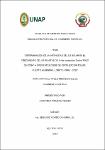Determinación de la intensidad de luz solar en el crecimiento de las plantas de Aniba rosaeodora Ducke "palo de rosa" a diferentes dosis de fertilización foliar, Puerto Almendra, Loreto, Perú - 2020
Abstract
The study was carried out at the Forestry Research and Education Center of the National University of the Peruvian Amazon in Plot IV, with the objective of determining the light intensity and the effect of three doses of foliar fertilization on growth in height and diameter. from Aniba Rosaeodora Ducke. It is of an observational and descriptive type between the variables under study. The results obtained show that, in the light intensity and diameter relationship: the good category from 0 to 4999.9 Lux, presented the highest average diameter increase with 1.83 mm., and the lowest average diameter increase presented the bad category from 10000 to 14999.9 Lux with 1.29mm. In the light intensity and height relationship, the regular category from 5000 to 9999.9 Lux, presented the highest average increase in height with 15.29 cm, and the lowest average increase in height presented by the bad category from 10000 to 14999.9 Lux, with 9.75 cm. In the foliar fertilization dose and diameter relationship, the highest average diameter increase was 1.88 mm, in the concentration of 60ml/20liter H2O of foliar fertilization, and the lowest average diameter increase was 1.70 mm, in the concentration of 40ml/20liters of H2O of foliar fertilization. In the foliar fertilization dose and height relationship, the highest average increase in height of 15.67 cm was in the concentration of 60 ml/20 liters of H2O from foliar fertilization, and the lowest average increase in height was 12.98 cm in the concentration of 40ml/20liters of H2O from foliar fertilization. It is recommended to use a light intensity in a range of 0 to 9,999.9 lux and use foliar fertilization in a concentration of 60ml of Bayfolan / 20liter H2O. El estudio se desarrolló en el Centro de Investigación y Enseñanza Forestal de la Universidad Nacional de la Amazonia Peruana en la Parcela IV, con el objetivo de determinar la intensidad de luz y el efecto de tres dosis de fertilización foliar en el crecimiento en altura y diámetro de Aniba rosaeodora Ducke. Es de tipo observacional y descriptivo entre las variables en estudio. Los resultados obtenidos muestran que, en la relación intensidad de luz y diámetro: la categoría bueno de 0 a 4999.9 Lux, presentó mayor incremento diamétrico promedio con 1.83 mm., y el menor incremento diamétrico promedio presentó la categoría mala de 10000 a 14999.9 Lux con 1.29 mm. En la relación intensidad de luz y altura, la categoría regular de 5000 a 9999.9 Lux, presentó el mayor incremento promedio en altura con 15.29 cm, y el menor incremento promedio en altura presentó la categoría mala de 10000 a 14999.9 Lux, con 9.75 cm. En la relación dosis de fertilización foliar y diámetro, el mayor incremento diamétrico promedio fue 1.88 mm, en la concentración de 60ml/20litro H2O de fertilización foliar, y el menor incremento diamétrico promedio fue 1.70 mm, en la concentración de 40ml/20litros de H2O de fertilización foliar. En la relación dosis de fertilización foliar y altura, el mayor incremento promedio en altura de 15.67 cm, fue en la concentración de 60 ml/20 litros de H2O de fertilización foliar, y el menor incremento promedio en altura fue 12.98cm, en la concentración de 40ml/20litros de H2O de fertilización foliar. Se recomienda utilizar una intensidad de luz en un rango de 0 a 9,999.9 lux y utilizar fertilización foliar en una concentración de 60ml de Bayfolan / 20litro H2O.
Collections
- Tesis [524]


